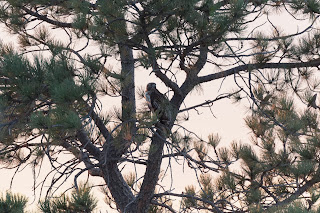Total Lunar Eclipse, September 27-28 2015

Jill and I went eclipse chasing this evening. I did initial research on the Clear Dark Sky site to see what conditions were going to be like. After digging, I decided that somewhere south and east of Briggsdale was likely to have clear skies. We ended up on the grounds of an old church called Osgood Church. We were greeted by this raptor, which we took as an auspicious omen: We were rewarded with gorgeous skies - only a few wispy clouds floated through occasionally. Here is an all-sky shot taken with my Canon EF 8-15mm f/4.0L lens on a Canon 5DmkII camera that shows how nice the skies were: Jill and I are there in the foreground next to the telescopes. You can see the eclipsed Moon, as well as the Milky Way and the skyglow from Fort Morgan, Sterling, and smaller towns off past the horizon. For the eclipse photos, I used a Canon 7DmkII camera on an Orion ED80T CF refractor - an 80mm diameter, f/6.0 480mm focal length triplet. I mo...


